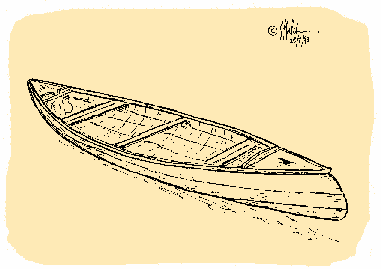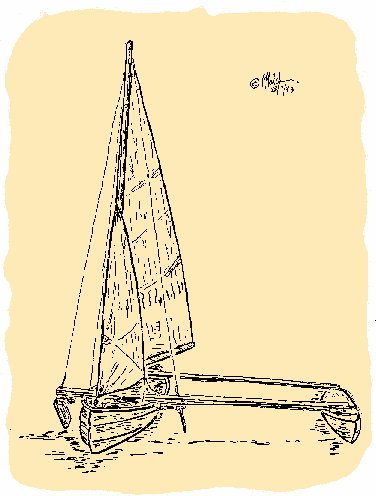 WHERE THERE'S A WILL...
WHERE THERE'S A WILL...

This is a tale from the Australian dark ages of the mid-'70s, when "boat" usually meant mass-produced models of startling similarity across the range, when shops, schools and services for amateur builders were fevered dreams in the minds of eccentrics, and an infant WoodenBoat hadn't yet reached the distant Antipodes.
We wanted a boat. Perhaps one of those gleaming fibreglass trailer-sailers which were starting to appear like mushrooms. We looked at some, but their prices and our piggy banks didn't match.
So we moved down-market to the Hartley TS16 and its imitators. But a TS16 still was a bit larger than the piggy bank, even if we built it ourselves. We continued to move downmarket, pausing a while at Herons, and at Mirror dinghies, and at various smaller things powered, sailed, rowed and paddled.
 At last we found a boat within reach of our piglet banks. Blockey the Boatbuilder, in Melbourne, was marketing an open canoe kit. The canoe was a graceful multi-chine, almost round-bottomed stitch-and-tape ply construction, with all panels precut, and simple to build. At close to sixteen feet long and nearly three feet maximum beam, it was incredibly roomy, and capable of carrying half a ton of people and camping gear.
At last we found a boat within reach of our piglet banks. Blockey the Boatbuilder, in Melbourne, was marketing an open canoe kit. The canoe was a graceful multi-chine, almost round-bottomed stitch-and-tape ply construction, with all panels precut, and simple to build. At close to sixteen feet long and nearly three feet maximum beam, it was incredibly roomy, and capable of carrying half a ton of people and camping gear.
The whole kit was a great beginners' introduction to boatbuilding, and had a very special advantage which none of our subsequent craft have even remotely approached -- we could build it in our front hallway and actually get the finished boat out the front door without demolition!
Tadpole the canoe was a very effective craft, great fun for exploring Murray River backwaters and the mangrove creeks north of Adelaide. But she did have to be paddled, and we tend to indolence.
After one of our mangrove-exploring expeditions, we had to cross two kilometres or so of open shallows, in the teeth of a strong south-westerly, to get back to our car. With two strokes forward and one stroke back, our love of paddling hit a low from which it has never recovered. We needed a sail! 
Our piglet banks had regressed to the point of being a gleam in some wild boar's eye. No thought this time of building or buying a proper sailboat. If we were to sail, it would have to be in Tadpole the canoe.
Now, under my father-in-law's evening teacup often rested a moth-eaten copy of Popular Mechanics "Build your boat right", vintage 1940-something. In this was a neat suggestion for converting a rowboat to a little sailboat. We thought the idea was worth trying. The one obvious problem, of Tadpole's zero initial stability, could be solved with an outrigger (thus muddling Canadian and South Sea Island ancestry).
There were only two basic requirements for the conversion. It had to leave the fabric of the original canoe intact, and it had to cost peanuts. Both requirements were in case the attempt was unsuccessful -- nothing would be lost.
A short multi-chine outrigger was designed on the kitchen table by constructing cardboard and sticky-tape models one after the other until it looked right, then taking panel dimensions from it. The outrigger was built using the absolute roughest grade of exterior plywood, the sort one sees fencing off building sites.
The outrigger booms were oregon, attached to the outrigger and swivelling on large galvanised bolts. The booms lined up with the canoe thwarts, and were bolted to them through pine floorboard scraps. The only alteration to the canoe was a minor bit of strengthening of the thwarts. 
Almost everything which involved strain attached to the booms, not the actual canoe. Two leeboards swivelled on mounts on the booms. The oregon mast, painfully rounded out of ordinary building lumber, was stepped on another scrap of pine flooring extending from the boom to the stem.
No expense was spared in the rigging. Only the best fencing wire was used for the shrouds and stays, elegantly twisted around the finest galvanised turnbuckles the local hardware shop could provide. The shiniest of verandah-awning blocks were selected, and through them was reeved the whitest cotton sashcord. The sail track was a top-of-the-range cupboard door runner, and the gooseneck was a finely crafted copper construction surplus to a plumbing job. The kicking-strap was scrupulously cut from an almost new inner tube.
The sails were brown canvas, another bit of exploitation of the in-laws' belongings. The sails had been their tent, or at least that part remaining after an exchange of views with a leaking gas bottle and a campfire. I'm reliably informed that professional sailmakers don't usually have to cope with charred bits in their cloth -- perhaps that's why our design and cut wasn't optimal. The sails were sewn on an almost extinct sewing machine, which gasped its last at the end of the job.
Steering this miracle of modern design posed problems. Fitting a rudder to the canoe would mean significant alteration to the canoe's stern -- verboten -- so we settled for an ordinary oar swung outboard on an outrigger boom. Eventually this had to be replaced by a much larger oar, mounted through a rowlock on the canoe and equipped with a large lump of lead, surplus to the same plumbing job from whence came the gooseneck, to keep it in the water.
All of this -- a sixteen-foot canoe, an eight foot outrigger, mast and boom, two outrigger booms, and a very large steering oar -- travelled in an ungainly heap on top of the compact family car, bringing a new dimension to the "car-topper" concept. Unloaded at convenient beaches and riversides, the pile resembled a combination lumberyard and hardware shop.
Whether it was the apparent jumble of junk, or perhaps the frenzy of people waving shifting spanners at each other while putting things together, we don't know. But from her first trials onward, Flying Tadpole the outrigger-semi-Canadian-sailing-canoe always, always gathered an audience. The most secluded and unpopulated waterfront would spontaneously generate people as we bolted her up. 
And yet Flying Tadpole looked good, once assembled, and graceful on the water. She sailed well, and quite fast. Her only real fault was poor turning, a bit akin to a steamroller, and this was easily fixed by judicious cheating with the steering oar. In hindsight, we made a lot of errors in our disposition of outriggers, leeboards, mast and sails -- but they mostly cancelled out. God smiles on innocents.
Flying Tadpole did display bad manners with waves. She cut them dead, driving straight through instead of over. On fishing trips, this could be an advantage, as caught fish were free to exercise themselves inside the hull provided they avoided the baling bucket. And in strong winds, the outrigger took great joy in its impersonations of space shuttles on one tack and submarines on the other. But I've seen catamarans do worse.
We sailed Flying Tadpole for years, and enjoyed her immensely. Eventually we sold her to start our climb into more conventional and larger craft. Perhaps the best compliment she ever received came after her four-year sojourn on Sydney Harbour. Just before we left Sydney to return to civilisation, we spotted an ad in the boating pages which said (surprise!) "TURN YOUR CANADIAN CANOE INTO A SAILING OUTRIGGER!" The ad went on to explain that everything just bolted on with no modification to the canoe necessary. Should we have patented the design?
Flying Tadpole was put together at a minimal cost, in almost total ignorance, in an age when the materials, information and help we now take for granted were almost totally lacking. So, if you want a boat now and haven't yet built one, what's your excuse?